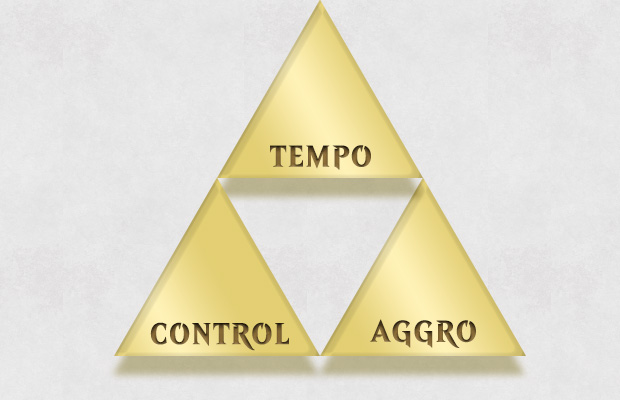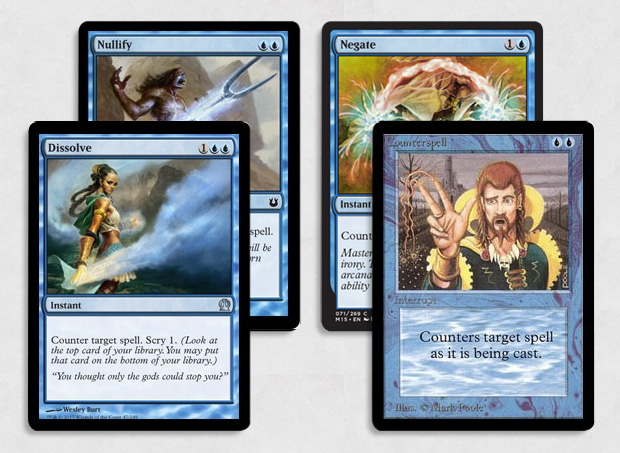Control Decks
Magic is a complicated game with many battles to be fought and many opportunities to gain advantages. Last week, we discussed aggro decks, which capitalize on tempo to win games. However, countless different strategies are possible in Constructed Magic, each focusing on different aspects of the game and earning advantages in different ways.
Control decks represent the polar opposite of aggro decks. Where aggro decks strive for speed, control decks are geared for the long game. While aggro decks win by executing their own game plan, control decks focus on shutting down the opponent, and win the game later, at their own convenience. We call them control decks because their goal is not to kill the opponent, but merely to control the game. Their top priority is to stop the opponent from executing his or her game plan. This can be an amazingly effective strategy and particularly appeals to players who enjoy playing long, and oftentimes complex, games.

Card Advantage in Control Decks
All Magic decks must be built with the concept of tempo in mind. Aggro decks aim to win the game (or at least gain a big advantage) through a fast start and a tempo advantage. On the other hand, control decks merely need to avoid falling so far behind in tempo that they lose the game because of it. Aggro decks want to get ahead in tempo. Control decks want to keep pace in tempo. Aggro decks want to win via tempo. Control decks are concerned with tempo only as it relates to defending themselves.
Instead, control decks typically get their edge through card advantage. If the control decks can succeed in surviving the early turns and making games go long, most opponents will run out of resources and peter out. The control deck itself, on the other hand, will become more and more powerful once its expensive spells and card advantage come online.
A control deck wants as much card advantage as it can get its hands on, and ideally it will come in the most simple and direct forms possible. Traditionally, a favorite mode of card advantage is simply to play with spells that allow you to draw extra cards.
Imagine a game that's reached turn ten or eleven. Your opponent, playing an aggro deck, is more or less spent. You've answered the early rush of creatures, and now the opponent is stuck simply drawing one card off the top of the library per turn. Often, this card will be a useless land.
You, on the other hand, are playing with a control deck featuring the card-drawing spells shown above. By turn eleven, you've cast several of these spells, so you've drawn about twenty-five cards out of your deck to your opponent's eighteen. This likely means you have more mana, more cards in your hand, and more relevant creatures and spells to fight with. Beating your opponent's measly one draw step per turn will be academic! If you have enough of these card-drawing spells in your deck, one will draw you into another into another and you'll never have to worry about suffering from mana flood. Your opponent will simply be buried in card advantage until eventually you'll find some powerful creature or Planeswalker to put your opponent out of his or her misery!
Inevitability
Your card advantage might come in any number of different forms via creatures, spells, Planeswalkers, or anything else. However, it must be there, and it must be there in a high enough concentration or else your deck will not function properly.
Control decks are built on the premise of inevitability. The deck must be powerful enough in the late game that its pilot can be confident in a win so long as he or she can defend him- or herself and drag the game out indefinitely.
Achieving inevitability is always the first step and the top priority when building a control deck. If you succeed in defending yourself against your opponent's early rush of creatures only to find yourself suffering from mana flood and losing anyway, then all of your efforts were wasted!
Inevitability is an important and complex concept that I'll be returning to in the future. For now, though, think of like this:
You have inevitability if your deck is powerful enough that you'll win a very high portion of games that go long.
Ensure that you have inevitability by building your deck with plenty of card advantage and powerful cards.
This white-blue deck is a very classic example of a control deck, featuring many of the most recognizable features of the archetype—a word we use for a recurring strategy with numerous possible variations.
Mana in Control Decks
The first thing to notice is the high land count: 26! We've already touched on the fact that card-drawing spells and powerful cards reduce the risk of mana flood (meaning that the deck can afford the risks of playing a high land count). However, we've not yet covered why it's so important for control decks to have a high concentration of mana.
While some of the aggro decks featured last week would be happy to never draw another land again beyond number three or four, control decks typically need to hit all of their land drops all the way into turn six, turn seven, and sometimes even beyond that. Since they're focused on the late game instead of the early game, control decks might not have as many cheap plays as other decks, and therefore cannot operate if they miss their land drops. Instead, they lean on powerful plays like End Hostilities and Elspeth, Sun's Champion to catch them up on tempo, so it's paramount that they have the mana to play those cards when the time comes.
Creatures in Control Decks
Newer players might also be shocked to see a deck featuring only two creatures. After all, the aggro decks featured last week had 28 or more, and I recommended a minimum of 14 creatures in Sealed Deck—and that's with 40 cards instead of 60! However, such a small creature count is actually not unusual for control decks. As mentioned above, control decks focus on defense and card advantage, and only seek to win the game later once they're firmly "in control." A small number of potent and reliable win conditions is the most effective way to execute this game plan.
There are a number of advantages that go along with a low creature count. One is that you can gain virtual card advantage by blanking your opponent's creature removal spells. Imagine yourself playing against this White-Blue Control deck and having a hand full of Murderous Cuts and Devouring Lights. What can you do with them? You can spend them on one of Elspeth, Sun's Champion's tokens, but that's hardly a winning battle. (It's also an exchange that leaves the control player ahead on card advantage). Or you can use them to tap Prognostic Sphinx for one turn. Either way, your removal spells are going to be stuck in your hand until the game is all but decided anyway. You will never have a chance to use them effectively.
A second advantage of having a low creature count is that your deck is configured in a way to make great use of symmetric effects. In the White-Blue Control example, End Hostilities is a tremendously powerful card that's central to your game plan. Fated Retribution and the -3 ability of Elspeth, Sun's Champion are also useful tools.
Permission Spells
Finally, this control deck features a category of cards that we've not yet discussed in Level One. These are permission spells (as in: "Please, Reid, may I pleeease cast my spell?").

We also call these counterspells because of their wording and in honor of their most iconic ancestor. (Counterspell itself would be too powerful by today's standards and has not been printed for many years).
Permission spells are great defensive tools as they can stop virtually any threat before it ever becomes a problem. Consider that Murderous Cut cannot prevent a creature like Siege Rhino from triggering its ability when it enters the battlefield, it cannot kill a Planeswalker, and it cannot stop an instant or sorcery. Dissolve can answer any of these problems.
Permission spells are ideal for control decks because of the way they contribute to the goal of inevitability. Once you get to the late game and things are going according to plan, having a Dissolve in your hand means there's very little your opponent can ever hope for in order to claw back into the game.
The only catch is that permission spells cannot help you to come back from behind; once a creature or Planeswalker is on the battlefield, you'll need to find another way to deal with it. Because of this, permission spells can be somewhat tricky to use properly during game play. There will be some times when you need to cast your Nullify on turn two on absolutely anything your opponent plays, just to avoid falling behind. (This is in a game where tempo is a big concern.) Other times you'll need to be very patient and save your Dissolve for some devastating threat your opponent might have, which you can't answer in any other way.
Having a mix of permission spells and removal spells is ideal, since that will give you the flexibility to handle any situation.
Building a Control Deck
When you build a control deck, your number one priority should be inevitability. Chock your deck full of enough card advantage and powerful cards that you feel very confident in winning the late game. If you fail to do this, your strategy simply won't work.
Next, focus on your early defense. All you want to do is survive, develop your mana, and generate card advantage. Do whatever you can to dismantle your opponent's aggression. You can use permission spells, removal spells, blocking creatures, or any number of other tools in order to do this. No one way is better than another so long as it allows you to survive long enough to begin overpowering your opponents in the late game.
Although I only featured one example of a control deck, they can come in a wide variety of forms. Blue is the most common control color (and the color of permission spells), but not all control decks are blue. Some seek to dominate the game with Planeswalkers; some achieve inevitability by recurring cards from their graveyard; some assemble powerful combinations of cards that are hard for their opponents to overcome. Whatever form they take, the heart of all control decks is the same: card advantage, inevitability, and defense.
Often, the late-game power of a control deck is too alluring to resist. A control deck can be an excellent choice for a tournament. Because of their complexity and the fact that they cause games to drag on for so long, there can be great rewards to practicing ahead of time and truly mastering a control deck.
However, be wary that building a control deck presents the special challenge: you have to be prepared for anything your opponents can throw at you. Know what strategies you're likely to run into and have a plan for utterly dismantling them. Do this, and before long, your opponents will be begging for mercy.

